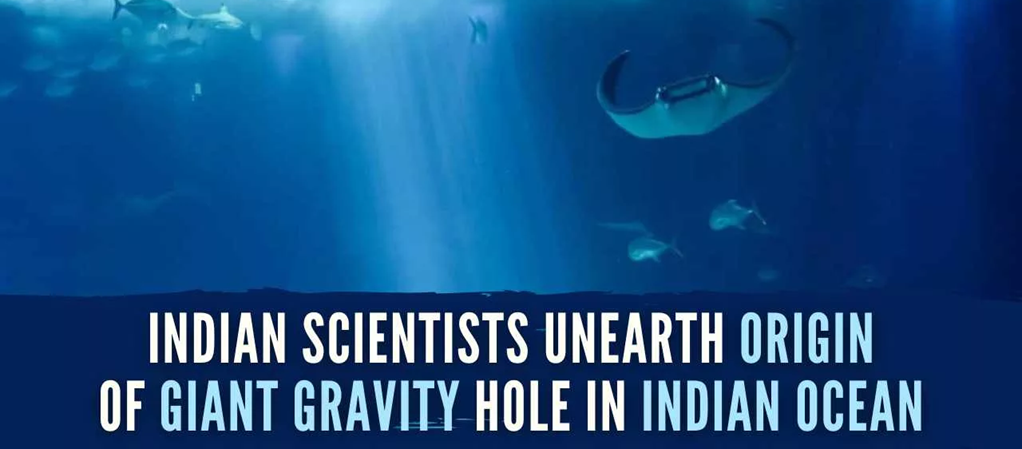Description

Copyright infringement not intended
Context: A team of scientists from the Indian Institute of Science has made a breakthrough discovery that could explain the origin of the anomalous "gravity hole" in the Indian Ocean. The gravity hole is a region where the gravitational pull is significantly lower than the surrounding areas, creating a dip in the Earth's gravity field.
Details
- The Earth's shape and gravity are not uniform across its surface. Instead, it is slightly flattened at the poles and wider at the equator. Moreover, the gravitational force varies depending on the mass distribution of the crust, mantle and core below each location. One of the most striking examples of this variation is the Indian Ocean geoid low (IOGL), a huge depression in the sea level that is about 106 metres lower than the global average, as reported by Scientific American.
- The IOGL was first detected in 1948 by Felix Andries Vening Meinesz, a Dutch geophysicist, during a ship-based survey. Later, it was confirmed by other experiments and satellite measurements. However, the cause of this anomaly remained a mystery for decades. Now, a new study has finally revealed the reason behind this phenomenon.
The journal Geophysical Research Letters published a research article by Debanjan Pal and Attreyee Ghosh, who are researchers from the Indian Institute of Science (IISc) in Bengaluru. They explain their hypothesis about the origin of the gravitational anomaly.
Methodology
- They used computer-simulated models to reconstruct the geological history of the past 140 million years. They discovered the traces of an ancient ocean that was about 965 kilometres deep under the Earth’s crust, below Africa, as reported by BBC.
- The simulations showed that there were molten rock plumes under Africa, which could have been formed by the subduction of tectonic plates into the mantle. They suggest that these plumes could be responsible for IOGL.
- However, they admitted to New Scientist that they did not have any clear seismic evidence to confirm the existence of the plumes in the simulations under the Indian Ocean. They think that there are other unknown factors that contribute to the dip that need to be investigated further.

Gravity hole
About
- It is a term used to describe a phenomenon where a region of space-time exhibits extremely strong gravitational forces that nothing can escape from it, not even light.
- They are usually formed by the collapse of massive stars, but they can also be created artificially by advanced technologies.
Features
- Gravity holes are mysterious and fascinating objects in the universe. They have some remarkable features that make them different from other celestial bodies.
Event horizon
- Gravity holes have a point of no return, called the event horizon, beyond which nothing can escape. Not even light can get out of a gravity hole once it crosses the event horizon. This is why they are invisible to our eyes and telescopes.
Singularity
- Gravity holes have a singularity, where the density and curvature of space-time become infinite. This means that the laws of physics break down at the centre of a gravity hole, and we do not know what happens there.
Distort the surrounding space-time
- Gravity holes can distort the surrounding space-time, causing gravitational lensing, time dilation, and redshift.
- Gravitational lensing is when a gravity hole bends the light from distant objects, creating multiple or distorted images of them.
- Time dilation is when time slows down near a gravity hole, making it seem like an eternity for an observer inside it.
- Redshift is when the light from a gravity hole loses energy and shifts to longer wavelengths, making it appear redder.
Hawking radiation
- Gravity holes can emit radiation, called Hawking radiation, due to quantum effects near the event horizon. This radiation is very weak and hard to detect, but it implies that gravity holes are not completely black and can lose mass over time.
Impact
- They can affect the formation and evolution of galaxies, stars, and planets.
- They can be sources of gravitational waves, which are ripples in space-time that carry information about violent events in the cosmos.
- They can be used as probes to test the theories of gravity and quantum mechanics and to explore the nature of space-time itself.
Significance
- They can challenge our understanding of reality and our place in the universe.
- They can offer opportunities for scientific discovery and technological innovation, as well as ethical dilemmas and existential risks.
Challenges
- They are extremely difficult to observe and measure, due to their invisibility and distance.
- They are extremely dangerous and unpredictable, due to their immense power and unpredictability.
- They require advanced instruments and methods, as well as rigorous theoretical models and simulations, to investigate and exploit them.
Way forward
- The Way forward for studying and understanding gravity holes would require a combination of theoretical and experimental approaches, as well as interdisciplinary and collaborative efforts.
Some possible steps are:
- Developing new models and hypotheses that can account for the existence and properties of gravity holes, using advanced mathematics and physics.
- Testing and verifying these models and hypotheses using observational data from astronomy and astrophysics, as well as laboratory experiments using high-energy physics and quantum mechanics.
- Exploring the implications and applications of gravity holes for various fields of science and technology, such as cosmology, relativity, thermodynamics, information theory, quantum computing and artificial intelligence.

Conclusion
- Gravity holes are hypothetical regions of space where the gravitational field is so strong that nothing, not even light, can escape. They are also known as black holes, and they are one of the most fascinating and mysterious phenomena in the universe. They are formed by the collapse of massive stars, and they can have various sizes and properties depending on their mass, spin and charge. They are also the subject of many theoretical and observational studies, as they can provide clues about the nature of gravity, quantum mechanics and the origin of the cosmos.
Must-Read Articles:
Gravitational wave: https://www.iasgyan.in/blogs/gravitational-waves
Gravitational Lensing: https://www.iasgyan.in/daily-current-affairs/gravitational-lensing
|
PRACTICE QUESTION
Q. What is the boundary of a gravity hole called?
A) The event horizon
B) The singularity
C) The wormhole
D) The black hole
Answer: A
Explanation: The event horizon is the point of no return for anything that falls into a gravity hole. It is the distance from the centre of the gravity hole where the escape velocity equals the speed of light.
|
https://indianexpress.com/article/technology/science/gravity-hole-indian-ocean-8761264/











